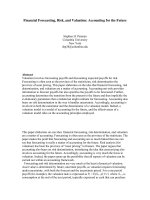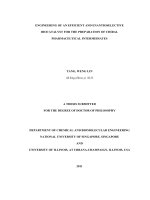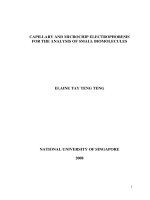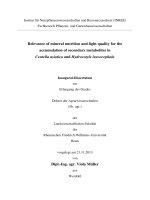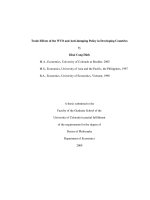Insurance: Solvency And Valuation - Thesis For The Degree Of Doctor Of Philosophy
Bạn đang xem bản rút gọn của tài liệu. Xem và tải ngay bản đầy đủ của tài liệu tại đây (1.22 MB, 35 trang )
✐
✐
✐
✐
Thesis for the Degree of Doctor of Philosophy
Insurance: solvency and valuation
Jonas Alm
Division of Mathematical Statistics
Department of Mathematical Sciences
Chalmers University of Technology
and University of Gothenburg
Göteborg, Sweden 2015
✐
✐
✐
✐
✐
✐
✐
✐
Insurance: solvency and valuation
Jonas Alm
ISBN 978-91-7597-195-7
© Jonas Alm, 2015.
Doktorsavhandlingar vid Chalmers tekniska högskola
Ny serie nr 3876
ISSN 0346-718X
Department of Mathematical Sciences
Chalmers University of Technology
and University of Gothenburg
412 96 Göteborg
Sweden
Phone: +46 (0)31-772 10 00
Printed in Göteborg, Sweden 2015
✐
✐
✐
✐
✐
✐
✐
✐
Insurance: solvency and valuation
Jonas Alm
Abstract
This thesis concerns mathematical and statistical concepts useful to assess an
insurer’s risk of insolvency. We study company internal claims payment data
and publicly available market data with the aim of estimating (the right tail
of) the insurer’s aggregate loss distribution. To this end, we also develop a
framework for market-consistent valuation of insurance liabilities. Moreover,
we discuss Solvency II, the risk-based regulatory regime in the European Union,
in some detail.
In Paper I, we construct a multidimensional simulation model that could be
used to get a better understanding of the stochastic nature of insurance claims
payments, and to calculate solvency capital requirements. The assumptions
made in the paper are based on an analysis of motor insurance data from the
Swedish insurance company Folksam. In Paper II, we investigate risks related
to the common industry practice of engaging in interest-rate swaps to increase
the duration of assets. Our main focus is on foreign-currency swaps, but the
same risks are present in domestic-currency swaps if there is a spread between
the swap-zero-rate curve and the zero-rate curve used for discounting insurance liabilities. In Paper III, we study data from the yearly reports the four
major Swedish non-life insurers have sent to the Swedish Financial Supervisory Authority (FSA). Our aim is to find the marginal distributions of, and dependence between, losses in the five largest lines of business. In Paper IV, we
study the valuation of stochastic cash flows that exhibit dependence on interest
rates. We focus on insurance liability cash flows linked to an index, such as a
consumer price index or wage index, where changes in the index value can be
partially understood in terms of changes in the term structure of interest rates.
Papers I and III are based on data that are difficult to get hold of for people
in academia. The FSA reports are publicly available, but actuarial experience
is needed to find and interpret them. These two papers contribute to a better
understanding of the stochastic nature of insurance claims by providing datadriven models, and analyzing their usefulness and limitations. Paper II contributes by highlighting what may happen when an idea that is theoretically
sound (reducing interest-rate risk with swaps) is applied in practice. Paper IV
contributes by explicitly showing how the dependence between interest rates
and inflation can be modeled, and hence reducing the insurance liability valuation problem to estimation of pure insurance risk.
Keywords: risk aggregation, dependence modeling, solvency capital requirement, market-consistent valuation
✐
✐
✐
✐
✐
✐
✐
✐
✐
✐
✐
✐
✐
✐
✐
✐
Preface
This thesis consists of the following papers.
⊲ Jonas Alm,
“A simulation model for calculating solvency capital requirements for non-life insurance risk”,
in Scandinavian Actuarial Journal 2015:2 (2015),
107–123.
DOI: 10.1080/03461238.2013.787367
⊲ Jonas Alm and Filip Lindskog,
“Foreign-currency interest-rate swaps in asset-liability management for insurers”,
in European Actuarial Journal 3:1 (2013), 133–
158.
DOI: 10.1007/s13385-013-0069-5
⊲ Jonas Alm,
“Signs of dependence and heavy tails in non-life
insurance data”,
in Scandinavian Actuarial Journal. Advance online publication.
DOI: 10.1080/03461238.2015.1017527
⊲ Jonas Alm and Filip Lindskog,
“Valuation of index-linked cash flows in a HeathJarrow-Morton framework”,
Preprint.
iii
✐
✐
✐
✐
✐
✐
✐
✐
✐
✐
✐
✐
✐
✐
✐
✐
Acknowledgements
As most good things, my time as a graduate student is about to come
to an end. I would like to take this opportunity to express my gratitude
to a number of people important to me.
To start with I would like to thank my advisors Filip Lindskog, Holger Rootzén and Gunnar Andersson for constant support, encouragement and inspiration during these years. Thank you Filip for a fruitful
research cooperation, for helping me formalizing ideas, and for continuously pushing my level of thinking to a higher level. Thank you Holger
for convincing me to apply for this position, for introducing me to the
subject of mathematical statistics, and for your hospitality. Thank you
Gunnar for being a great boss, for sharing your knowledge and experience from both the insurance industry and academia, and for helping me
when I needed it. Moreover, I would like to thank my industry advisors
Bengt von Bahr, Erik Elvers and Åsa Larson at Finansinspektionen, and
Jesper Andersson at Folksam, for valuable input and many interesting
discussions. Thanks also to Magnus Lindstedt at Folksam for inspiring
asset management discussions.
I would further like to express my warm thanks to Mario Wüthrich
and the other members of ETH Risklab for making the stay in Zürich a
pleasure for my family and me. A special thank you to Galit Shoham for
help finding an apartment.
Many thanks go to two people important to me during my time as
a master’s student. Thank you Christer Borell for advising my master’s thesis and for numerous interesting investment strategy discussions. Thank you Allen Hoffmeyer for guiding me in Atlanta, and
through Chung’s book.
Thanks to my former office mates at Folksam: Jesper, Micke, Mårten,
Erik, Lasse, Tomas, and the other actuaries. Thanks also to my current
v
✐
✐
✐
✐
✐
✐
✐
✐
vi
ACKNOWLEDGEMENTS
and former colleagues, senior faculty and fellow graduate students, at
Chalmers and KTH: Magnus, Peter, Dawan, Hossein, and others.
Finally, thank you Linnéa, Vilhelm and Ludvig for your patience and
support. You mean everything to me. I love you.
Jonas Alm
Göteborg, May 2015
✐
✐
✐
✐
✐
✐
✐
✐
Contents
Abstract
i
Preface
iii
Acknowledgements
v
Part I. INTRODUCTION
1
Introduction
1. A first overview
2. From ruin theory to risk measures
3. The valuation framework
4. Dependence modeling
5. Summary of papers
6. Some thoughts about solvency modeling and regulation
References
3
3
6
9
14
18
21
22
Part II. PAPERS
25
Paper I. A simulation model for calculating solvency capital
requirements for non-life insurance risk
1. Introduction
2. Theory and model
3. Data analysis
4. Simulation setup
5. The Solvency II standard model
6. Results and discussion
References
A. Data plots
29
29
32
37
41
43
45
48
50
vii
✐
✐
✐
✐
✐
✐
✐
✐
viii
CONTENTS
Paper II. Foreign-currency interest-rate swaps in asset-liability
management for insurers
1. Introduction
2. The insurer’s assets and liabilities
3. Data and extreme-value analysis
4. Key risk factors and extreme scenarios
5. Conclusions and discussion
References
A. Figures
55
55
56
62
68
77
78
80
Paper III. Signs of dependence and heavy tails in non-life
insurance data
1. Introduction
2. Notation
3. Data
4. Data analysis
5. Modeling and SCR calculation
6. The standard formula in Solvency II
7. Discussion
References
93
93
95
96
99
105
108
111
114
Paper IV. Valuation of index-linked cash flows in a Heath-JarrowMorton framework
1. Introduction
2. Preliminaries
3. Valuation of an index-linked cash flow
4. Model selection and validation
5. Model-based valuation
6. Discussion
References
A. Proofs
B. Figures
119
119
122
127
131
138
141
143
144
149
✐
✐
✐
✐
✐
✐
✐
✐
✐
✐
✐
✐
✐
✐
✐
✐
✐
✐
✐
✐
✐
✐
✐
✐
Part I
INTRODUCTION
✐
✐
✐
✐
✐
✐
✐
✐
✐
✐
✐
✐
✐
✐
✐
✐
Introduction
1. A first overview
Insolvency occurs when a company is unable to meet its financial
obligations. A lack of liquidity to pay debts as they fall due is called
cash-flow insolvency, and the event that the value of a company’s liabilities exceeds the value of its assets is called balance-sheet insolvency or
technical insolvency. This thesis concerns mathematical and statistical
concepts used to assess the risk of balance-sheet insolvency, and hence
could be used as tools for risk management decisions.
Given some valuation method and a pre-defined time period, the loss
on an asset is the negative change in asset value over the period. The loss
on a liability is the positive change in liability value over the period. The
aggregate loss is the sum of losses on all individual assets and liabilities.
For a future time period, the aggregate loss and the individual losses
may be viewed as random variables. The distribution of the aggregate
loss, in particlar the right tail of the distribution, determines the risk of
insolvency.
The challenge in solvency modeling is to estimate the right tail of
the aggregate loss distribution as well as possible. The first modeling
step is to decide on valuation methods to use given some overarching
valuation principle. For example, if market-consistent valuation is the
principle, then the valuation method for assets (and liabilities) traded
in deep and liquid markets is to observe market prices. For non-traded
liabilities (and assets) a valuation method based on a subjective choice of
state price deflator (stochastic discount factor) may be used. The second
step is to decide on a segmentation of asset and liability classes that
is optimal in some sense, and the third and final step is to model the
marginal distributions and dependence structure of the losses on these
classes.
3
✐
✐
✐
✐
✐
✐
✐
✐
Introduction
Governments impose regulations on insurers in order to reduce their
probability of insolvency and thereby protect the policyholders. Regulatory frameworks for insurers differs between jurisdictions. For example,
the countries in the European Union are about to implement Solvency
II, and Switzerland has the Swiss Solvency Test (SST). A short overview
of the Solvency II framework is given in the end of this section. The
remainder of the introduction is organized as follows. In Section 2, we
define the one-period loss of an insurer and introduce the concept of
risk measures. We explain how insurance liabilities can be valued using
state price deflators in Section 3. Section 4 is devoted to construction
and modeling of liability losses, and modeling dependence between asset and liability losses. Summaries of the papers included in this thesis
are found in Section 5, and some final thoughts are given in Section 6.
1.1. Solvency II. The regulatory regime Solvency II will harmonize the
solvency rules for insurers in the European Union. The Solvency II Directive, which is a recast of several EU directives [15–17], will enter into
force on January 1, 2016. The Delegated Act of Solvency II [14] contains implementing rules that set out more detailed requirements for
insurers. The Solvency II Directive replaces 14 existing EU directives
commonly known as “Solvency I”. While Solvency I focuses on the insurance risks on the liability side of the balance sheet and uses a crude
volume-based capital requirement model, Solvency II takes a total balance sheet approach where all risks and their interactions are supposed
to be considered. For a historical overview of the steps towards Solvency
II, see [27].
The framework is divided into three areas, called pillars. Of main
concern for this thesis is Pillar 1, which sets out quantitative requirements, including the rules to value assets and liabilities and to calculate
capital requirements. Pillar 2 sets out requirements for risk management, governance and supervision, and Pillar 3 addresses transparency
and disclosure.
The most well-known capital requirement level is the Solvency Capital Requirement (SCR) which “shall correspond to the Value-at-Risk of
the basic own funds of an insurance or reinsurance undertaking subject
to a confidence level of 99.5% over a one-year period” [15, Article 101].
The “basic own funds” are essentially the difference in value between
the insurer’s assets and liabilites. The other capital requirement level is
4
✐
✐
✐
✐
✐
✐
✐
✐
Introduction
the Minimum Capital Requirement (MCR) which is volume based and
similar in structure to the capital requirement in Solvency I. There is
a standard formula for SCR calculation in Solvency II, but insurers also
have the possibility to develop and use their own (full or partial) internal
models to calculate SCR. The SCR and MCR may be viewed as soft and
hard levels of intervention. If an insurer breaches the SCR, the regulator
will intervene to make sure that the insurer takes the appropriate actions to restore SCR. Breaching the MCR will trigger serious regulatory
intervention and potential closure of the company.
The fundamental valuation principle in Solvency II is that all assets and liabilities on the insurer’s balance sheet should be valued in a
market-consistent way. This means that the value of an asset or a liability traded in a deep and liquid market is set to the price paid in
the latest market transaction. However, liabilities arising from contractual obligations towards policyholders, known as technical provisions,
are in general not traded. The directive states that “the value of technical provisions shall be equal to the sum of a best estimate and a risk
margin”, where “the best estimate shall correspond to the probabilityweighted average of future cash-flows, taking account of the time value
of money” and “the risk margin shall be such as to ensure that the value
of the technical provisions is equivalent to the amount that insurance
and reinsurance undertakings would be expected to require in order to
take over and meet the insurance and reinsurance obligations” [15, Article 77].
In general, insurance risk cannot (and should not) be hedged. Thus,
any model for insurance liability valuation must somehow include the
market price of insurance risk. A mathematical interpretation of the
above quotes is that the best estimate is calculated under the assumption
that the market price of risk is zero.The risk margin is then calculated as
the cost of holding the solvency capital until all claims are settled, with
the cost-of-capital rate set to 6% (see [14, Articles 37–39] for details).
The cost-of-capital rate is here interpreted as the expected return in excess of the risk-free rate an investor will require in order to take over the
insurance obligations.
5
✐
✐
✐
✐
✐
✐
✐
✐
Introduction
2. From ruin theory to risk measures
In this section we start from the classical Cramér-Lundberg model
and arrive at a modern setup for solvency modeling based on one-period
losses. The line of presentation is inspired by [32].
The theoretical foundation of collective risk theory, also known as
ruin theory, was laid by Lundberg in his doctoral thesis [23]. The pioneering work of Lundberg was later treated with mathematical rigor
by Cramér [6, 8]. In the Cramér-Lundberg model, the surplus process
(Xt )t≥0 of the insurer is given by
Nt
Xt = x0 + ct −
ηi ,
i=1
t ≥ 0,
where x0 ≥ 0 is the initial surplus, c > 0 is the premium rate, (ηi )i∈N
are strictly positive iid claim amounts with finite mean, and (Nt )t≥0 is a
homogeneous Poisson process. The claim amounts (ηi )i∈N and the numNt
ber of claims (Nt )t≥0 are assumed to be independent, so
i=1 ηi t≥0 is a
compound Poisson process.
The main quantity of interest in the Cramér-Lundberg model is the
probability of ultimate ruin,
P inf Xt < 0 ,
t≥0
and there are many interesting mathematical results related to this probability. For example, the origin of the theory of large deviations (see [29])
is traced back to work by Esscher [13] and Cramér [7]. Ruin theory for
heavy-tailed claim amount distributions is covered in e.g. [10, Chapter 1].
In practice, it is not possible to continuously assess the value of an
insurer’s surplus, so for statistical purposes we consider the discrete version of the ultimate ruin probability,
P inf Xj < 0 .
j∈N
A modern interpretation is that x0 represents the insurer’s initial equity,
i.e. the difference in value between assets and liabilities. Given that new
equity may be injected by the owners of the insurance company at each
6
✐
✐
✐
✐
✐
✐
✐
✐
Introduction
time step it makes sense to study the one-period ruin probability,
P (X1 < 0) .
In this modern interpretation, c includes not only the earned premium
but also the return on assets over the period. We drop the compound
N1
Poisson process assumption, i.e. we allow i=1
ηi to have any distribuN1
tion. Moreover, i=1 ηi is assumed to include not only new claims but
also revaluation of existing, not yet completely settled, claims. Putting
all this together, we get
N1
X 1 = x0 + c −
i=1
ηi = A0 − L0 + A1 − A0 − (L1 − L0 ) = A1 − L1 ,
where Ai and Li , i = 0, 1, are the values of assets and liabilities, respectively, of the insurer at time i.
We define the one-period profit Y1 as the change in equity over the
period, i.e.
Y1 = A1 − L1 − er0 (A0 − L0 ),
where r0 denotes the one-period risk-free rollover at time 0. The discounted one-period loss Z1 is defined by
Z1 = −e−r0 Y1 = A0 − L0 − e−r0 (A1 − L1 ).
Understanding the probability distribution of the insurer’s loss Z1 (or
profit Y1 ) is the key for both strategic business decisions and risk management.
2.1. Risk measures and capital requirements. A risk measure tries to
summarize the risk of the entire probability distribution of the future
equity value (or the change in equity value) in a single number. Let V be
a linear vector space of random variables V representing values of the
insurer’s equity at time 1. A risk measure ρ is then defined as a mapping from V to R ∪ ∞. The quantity ρ(V ) is interpreted as the minimum
amount of cash that needs to be added to the insurer’s equity at time 0
in order to make the position with value V at time 1 acceptable. If no
cash is needed, i.e. ρ(V ) ≤ 0, then the position is considered acceptable.
A risk measure ρ is called a monetary risk measure if it is:
(1) translation invariant, i.e. ρ(V + aer0 ) = ρ(V ) − a for all a ∈ R, and
(2) monotone, i.e. V2 ≤ V1 implies that ρ(V1 ) ≤ ρ(V2 ).
It is called a coherent risk measure if it is also:
7
✐
✐
✐
✐
✐
✐
✐
✐
Introduction
(3) positively homogenous, i.e. ρ(aV ) = aρ(V ) for all a ≥ 0, and
(4) subadditive, i.e. ρ(V1 + V2 ) ≤ ρ(V1 ) + ρ(V2 ).
The notion of coherent risk measures was introduced in [1]. More about
risk measures and their properties are found in [21, Chapter 6].
Any monetary risk measure ρ determines a capital requirement. Using the translation invariance property, we get
ρ(A1 − L1 ) = ρ(Y1 + er0 (A0 − L0 )) = ρ(Y1 ) + L0 − A0 .
The insurer’s portfolio of assets and liabilities is accepted by the regulator if ρ(A1 − L1 ) ≤ 0, which is equivalent to
A0 ≥ L0 + ρ(Y1 ),
i.e. today’s value of assets must exceed today’s value of liabilities by at
least the capital requirement ρ(Y1 ).
The two most commonly used risk measures are Value-at-Risk (VaR)
and Expected Shortfall (ES). Given a confidence level p ∈ (0, 1) and an
equity value V at time 1, the (one-period) Value-at-Risk is defined by
VaRp (V ) = min{a : P (aer0 + V < 0) ≤ p}
= min{a : P (Z > a) ≤ p} = FZ−1 (1 − p)
where Z = −e−r0 V and F·−1 denotes the quantile function. The (oneperiod) Expected Shortfall is defined by
ESp (V ) =
1
p
p
0
VaRu (V ) du =
1
p
1
1−p
FZ−1 (u)du.
Notice that
P (X1 < 0) < p
⇔
⇔
P (Z1 ≤ A0 − L0 ) ≥ 1 − p
A0 ≥ L0 + FZ−11 (1 − p),
so setting an upper bound of the one-period ruin probability is equivalent to choosing Value-at-Risk as risk measure.
In Solvency II, the choice of risk measure is VaR at level 0.005 over
a one-year horizon (see [15, Article 101]). The solvency capital requirement is thus given by
SCR = VaR0.005 (Y1 ) = FZ−11 (0.995),
8
✐
✐
✐
✐
✐
✐
✐
✐
Introduction
where Z1 = −e−r0 Y1 is the (discounted) one-year loss. Since VaR at level
0.005 is the 0.995-quantile of the one-year loss distribution, the SCR in
Solvency II is often referred to as ”the Value-at-Risk at level 99.5%”.
The risk measure used in the Swiss Solvency Test is ES at level 0.01
over a one-year horizon (see [28]), so the SCR is given by
1
SCR = ES0.01 (Y1 ) = 100
0.99
FZ−11 (u)du.
On the one hand, ES should be a better measure of risk than VaR
since it takes the entire right tail of the one-period loss distribution into
account. Moreover, ES is a coherent risk measure while VaR is not. On
the other hand, there are very few data available on the extreme levels
specified by the regulators, so in practice the statistical problem (more
or less) boils down to determining the shape of the right tail, and the
variance, of the loss distribution given a total number of, say, 20 observations.
3. The valuation framework
In this section we introduce the concept of state price deflators (stochastic discount factors), as presented in [31], to create valuation functionals for insurance liability cash flows. Moreover, we show how a state
price deflator defines a risk-neutral probability measure. The existence
of a risk-neutral measure is equivalent to absence of arbitrage opportunities in the market.
We consider a discrete-time setting given by a filtered probability
space (Ω, F , F , P), where F = (Ft )t=0,...,T , with Ft denoting the information available at time t. Here, P is the real-world probability measure
under which all cash flows and price processes are observed, and the
expectation operator with respect to P is denoted by E. We let P(t, u)
denote the price at time t of a non-defaultable zero-coupon bond maturing at time u ≥ t, with P(u, u) = 1 by convention, and rt = − log P(t, t + 1)
denote the one-period risk-free rollover at time t.
Each asset or liability has a corresponding F -adapted price process
(ξt )t=0,...,T , where ξt denotes the price at time t. For assets (or liabilities)
traded in deep and liquid markets, we equate ξt with the market price
at time t.
If no (deep and liquid) market exists, we view a liability (or an asset) as a stochastic cash flow X = (X0 , . . . , XT ), where Xt is the payment
9
✐
✐
✐
✐
✐
✐
✐
✐
Introduction
due at time t. We decide on a valuation functional Qt that maps the
cash flow to a market-consistent (liability) value at time t, and set ξt =
− Qt (X ). In general, the market of insurance liabilities is incomplete
which implies that there are infinitely many valuation functionals that
allow for arbitrage-free pricing. One should aim for a valuation functional that correctly captures the risk appetite of the market participants, and yields a simple change of measure between the risk-neutral
and the real-world probability measures.
3.1. State price deflators. A cash flow X is an F -adapted random vector with integrable components, and we write X ∈ L1 (Ω, F , F , P). A state
price deflator ϕ = (ϕ0 , . . . , ϕT ) ∈ L1 (Ω, F , F , P) is a strictly positive random vector with normalization ϕ0 ≡ 1. The component ϕt transports a
random cash amount Xt at time t to a value at time 0.
The set of cash flows that can be valued relative to a given state price
deflator ϕ is
T
1
< ∞
,
F
ϕ
|X
|
Lϕ =
X
∈
L
(Ω,
F
,
F
,
P)
:
E
0
t
t
t=0
and the value at time t of a cash flow X ∈ Lϕ is defined by
T
1
Qt (X ) = E
ϕu Xu Ft , t = 0, . . . , T .
ϕt
u=0
By the tower property of conditional expectation,
T
ϕu Xu Ft+1 Ft
E (ϕt+1 Qt+1 (X ) |Ft ) = E E
u=0
T
ϕu Xu Ft = ϕt Qt (X ) .
= E
u=0
So, the deflated price process (ϕt Qt (X ))t=0,...,T is a (P, F )-martingale.
The cash flow corresponding to a zero-coupon bond maturing at
time u consists of one single deterministic payment of size 1 at time
u. Thus, for any state price deflator ϕ, the condition
P(t, u) =
1
E (ϕu |Ft ) ,
ϕt
t ≤ u,
10
✐
✐
✐
✐
✐
✐
✐
✐
Introduction
must be fulfilled.
3.2. Equivalent martingale measure. The value Bt of one unit of the
bank account at time t is given by
t
B0 = 1 and Bt = exp
r
, t ≥ 1.
s−1
s=1
P∗ ,
We define a probability measure
equivalent to P, via the RadonNikodym derivative
dP∗
F = ϕt Bt > 0.
dP t
We have
−1 −1
−1
E∗ B−1
t+1 Qt+1 (X ) |Ft = Bt ϕt E (ϕt+1 Qt+1 (X ) |Ft ) = Bt Qt (X ) ,
∗
(see e.g. [31, Lemma 11.3.]), i.e. (B−1
t Qt (X ))t=0,...,T is a (P , F )-martingale. The martingale measure P∗ is often called a risk-neutral measure.
According to the Fundamental Theorem of Asset Pricing, the existence
of a risk-neutral measure P∗ is equivalent to that the market is free of
arbitrage (see e.g. [9, Section 1.6.] or [19, Theorem 5.16.]). In general,
there exist more than one risk-neutral measure which implies that the
market is incomplete.
A natural way to model state price deflators is to set up a model
for the interest-rate dynamics under P∗ such that it via a convenient
change of measure yields interest-rate dynamics under P that are in
line with historical observations of interest-rate changes. Typically, the
change of measure corresponds to a Girsanov transformation, where
the kernel can be interpreted as the market price of risk. In this case,
the Radon-Nikodym derivative is completely determined by the marketprice-of-risk function, which may be estimated from historical interestrate changes. For an introduction to interest-rate modeling, see [4], [18]
(continuous time) or [31] (discrete time).
3.3. Non-life insurance liabilities. Consider a fixed non-life insurance
liability class (or line of business), and let Xi,j denote the (incremental)
claims payment for accident period i and development period j, i.e. the
amount paid in accounting period i + j for claims in accident period i.
Moreover, let J denote the ultimate development period, i.e. Xi,j = 0 if
j > J.
11
✐
✐
✐
✐
✐
✐
✐
✐
Introduction
Accident
period
−J + 1
−J + 2
..
.
1
..
.
Development period
0
1
···
J
X−J+1,J
.
. . X−J+2,J
..
.
.
..
..
.
X1,0
..
.
X1,1
..
.
···
X1,J
..
.
···
K
XK,0 XK,1 · · ·
XK,J
Table 1. Future claims payments at time 0.
˜ = (0, X˜ 1 , . . . , X˜ T ), where
At time 0, the insurer’s liability cash flow is X
T = J + K, and
min (t,K)
X˜ t =
Xi,t−i ,
t = 1, . . . , T ,
i=−J+t
with K denoting the minimum integer greater than or equal to the maximum remaining lifetime of contracts written at time 0. Since most nonlife insurance contracts have a lifetime of one year, K is often the number
˜
of periods in one year. The claims payments included in the cash flow X
are shown in Table 1.
For a given state price deflator ϕ, we have
˜ = 1
Qs X
ϕs
T
t=1
E ϕt X˜ t |Fs ,
s = 0, 1.
˜ to calculate
In the most general case we need a joint model for ϕ and X
˜
˜
Qs (X ). Here, we consider the case Xt = It Yt , t = 1, . . . , T , where It is
the value of an index at time t that may depend of ϕ, and Yt is a pure
insurance risk independent of both the state price deflator and the index.
The index could be, e.g., a consumer price index, a wage level index, or
a claims inflation index.
We have
1
1
E ϕt X˜ t |Fs = E (ϕt It |Fs ) E (Yt |Fs )
ϕs
ϕs
= Bs E∗ B−1
t It |Fs E (Yt |Fs ) ,
12
✐
✐
✐
✐
✐
✐
✐
✐
Introduction
and hence,
˜ = Bs
Qs X
(1)
T
E∗ B−1
t It |Fs E (Yt |Fs ) ,
t=1
s = 0, 1.
Thus, to value the cash flow we need both a method to calculate E (Yt |Fs ),
and a joint model for the bank account and the index under P∗ .
We set
(s)
(s)
with Yˆt :=
E (Yt |Fs ) = Yˆt ,
min (t,K)
(s)
Yˆi,t−i ,
i=−J+t
(s)
where Yˆi,j is a prediction of the index-adjusted payment Yi,j = Xi,j /Ii+j
at time s given some actuarial method, e.g. the chain-ladder method (see
[24]) or the Bornhuetter-Ferguson method (see [3]) with some additional
assumptions regarding future accident periods where no payments yet
are made.
Notice that if there is a bond linked to the index, then
1
B−1
s Is
E∗ B−1
t It |Fs = Pr (s, t),
where Pr (s, t) denotes the price at time s of an index-linked zero-coupon
bond maturing at time t. In this case,
˜ = Is
Qs X
T
t=1
Pr (s, t)E (Yt |Fs ) ,
s = 0, 1,
so there is no need for a joint model for the bank account and the index.
˜ and ϕ, i.e.
In Papers I and III, we assume independence between X
we set It = 1 for all t. Moreover, we assume a low-interest-rate environment and use the approximation
(2)
˜ ≈
Qs X
T
t=1
E (Yt |Fs ) ,
s = 0, 1.
In Paper IV we model state price deflators and the market price of risk
in a Heath-Jarrow-Morton (HJM) framework. Moreover, we give a suggestion of how to model the dependence between interest rates and the
index under P∗ .
13
✐
✐
✐
✐

